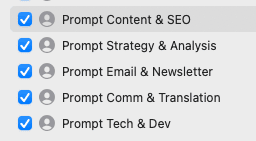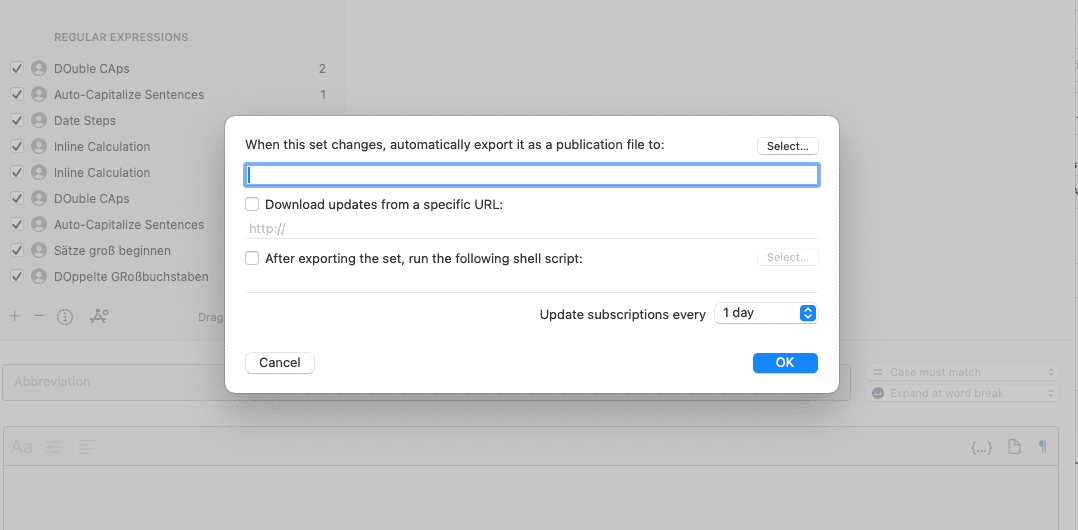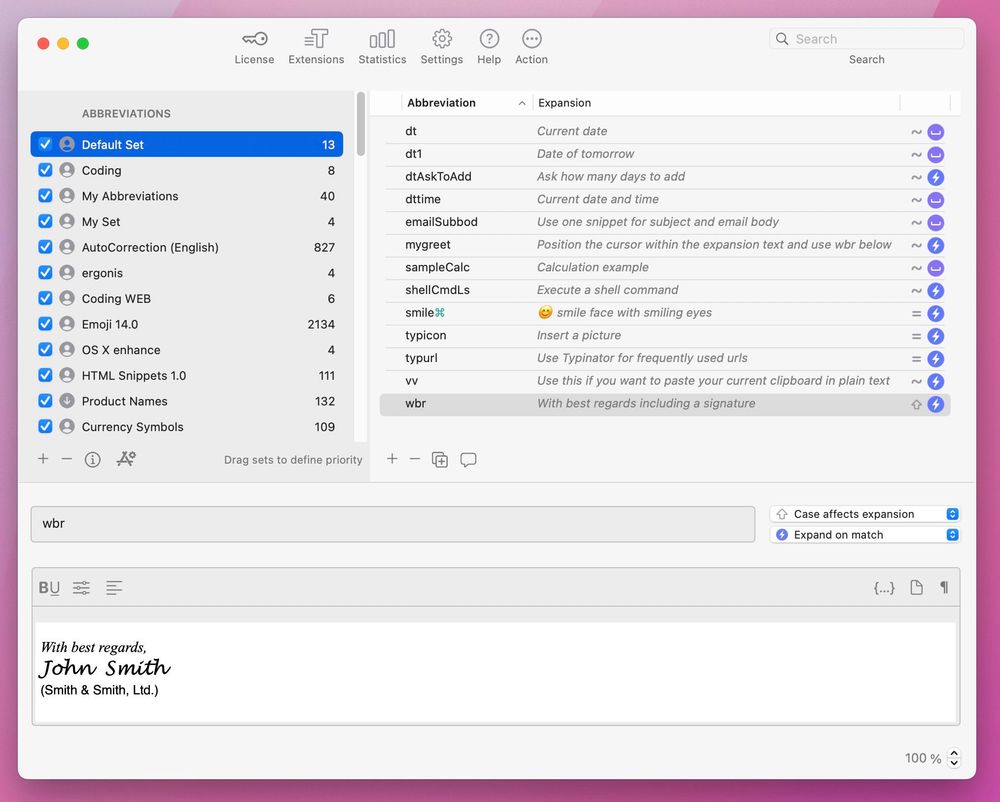Prompt management guide: Build your own prompt library & organise prompts efficiently

Introduction
Prompt management involves systematically organising, storing, and retrieving AI prompts to boost productivity and consistency. If you use ChatGPT, Claude, or other AI tools daily, you've probably faced the frustration of:
- recreating the same prompts,
- struggling to remember that perfect prompt from last week,
- typing the same instructions over and over again,
- or drowning in copy-paste chaos.
A well-organised prompt library turns chaotic prompt usage into efficient workflows. If you work with AI regularly, organising your prompt collection saves time, maintains consistency, and supports team collaboration.
In this guide, I will show you how to build and manage your own prompt hub and, more importantly, how to actually use it.
What is prompt management?
Prompt management refers to the systematic approach of collecting, categorising, storing, and maintaining AI prompts for efficient reuse. Think of it as creating a personal or team database where your most effective prompts live in an organised, searchable format.
Key terminology explained:
| Term | What It Does | Best Used For |
|---|---|---|
| Prompt collection | Basic gathering of prompts without advanced features | Informal use or initial creation |
| Prompt library | Organised collection of reusable prompts with tagging | Quick reference, personal workflows |
| Prompt hub | Central repository with search and filtering | Team or organisation-wide use |
| Prompt organiser | Tool to categorise, sort, and find prompts quickly | Fast retrieval, workflow optimisation |
| Prompt management tool | Software with version control and collaboration features | Enterprise, multi-user environments |
Each concept plays a unique role in prompt handling, from personal note-keeping (collection) up to robust team management (management tool).
Why do you need a prompt library?
Without proper organisation, valuable prompts get lost in chat histories, scattered across documents, or forgotten entirely. You save valuable time because you type less and automate repetitive work. A structured approach ensures your best-performing prompts remain accessible and actionable, turning one-time discoveries into repeatable assets.
Why you should organise prompts
1. Efficiency gains
Organising prompts eliminates the need to recreate effective instructions from scratch. Instead of spending 10-15 minutes crafting the perfect prompt, you can retrieve proven templates instantly.
Before prompt organisation: 2-3 hours/week searching, recreating, and typing prompts
After prompt organisation: 5 seconds per prompt using shortcuts
2. Consistency across projects
Marketing and other teams benefit enormously from standardised prompt collections. When everyone uses the same brand voice prompts, content maintains a consistent tone and messaging. Product descriptions, social media posts, and email campaigns align seamlessly when sourced from the same prompt library.
3. Speed through automation and shortcuts
The greatest efficiency gain comes from automating repetitive work and reducing typing. Instead of manually copying prompts from documents or databases, a system with keyboard shortcuts provides instant access.
Text expander tools like Typinator allow you to trigger entire prompts with just a few keystrokes (e.g., /blog expands to your complete blog outline prompt). This approach eliminates context switching, reduces errors, and transforms prompt usage from a multi-step process into a single action.
Who needs prompt management most?
Beginners benefit from having proven prompts readily available rather than starting from scratch each time. Marketing teams need consistency across campaigns and content. AI professionals and consultants require extensive, well-organised libraries to serve diverse client needs efficiently.
Content creators, social media managers, and especially customer support teams see immediate productivity gains from organised prompt collections. Even developers using AI coding assistants find structured prompt libraries essential for maintaining code quality.
Knowledge preservation
Your best prompts represent learned expertise. Without proper storage, team members leave and take their prompt knowledge with them. A centralized prompt hub captures this intellectual property, making it available to current and future team members.
Frameworks for building a prompt library
Start simple with use-case categories
Begin with broad categories matching your primary activities:
- Content Creation: Blog posts, social media, newsletters
- Analysis: Data interpretation, research summaries, competitive analysis
- Communication: Email templates, meeting summaries, proposals
- Technical: Code reviews, documentation, troubleshooting
- Creative: Brainstorming, ideation, storytelling
Add tags for flexible retrieval
- Tags help organize prompts by topics, use cases, or types (e.g., content creation, analysis, creative)
- Multiple tags allow flexible filtering and faster retrieval
- Additional metadata like AI model compatibility, complexity, or target audience can also be added
Track essential metadata
Keep it simple – most people need only:
- Title, category, and tags for easy finding
- Creation date and author for accountability
- Performance notes (what works, what doesn't)
- Version number if you update prompts frequently
Don't overcomplicate this. A title, category, and the prompt text itself are enough to start.
The "prompt graveyard" problem
Let's address why most prompt organization systems fail. Jeff Su identifies a critical mistake most people make: organizing by where you found prompts, not where you'll use them.
The typical (failed) approach:
Save prompts → Organize perfectly → Create categories → Add tags
Result: You never use them.
Why this fails:
Your brain doesn't think "Let me check my prompt database." It thinks "I need to prepare for this 1:1 meeting." The gap between finding a great prompt and actually using it creates what Jeff calls "The Prompt Graveyard" – beautifully organized collections that nobody touches.
The solution: Context-based organization
Don't organize by:
- Topic
- Category
- Date found
- Source
Instead, organize by:
- Where you'll use it
- When you'll need it
- How you'll trigger it
This means embedding prompts directly in your workflow where you're already working, or using instant-access tools that eliminate friction.
Successful examples from real users
Ulrike Ahmad's thematic approach
I asked Ulrike Ahmad, a LinkedIn expert and AI productivity specialist, how she manages her prompts. She organizes prompts thematically – sorting by categories like writing, marketing, and strategy. Her system includes setting up small AI assistants within Notion for her most-used prompts, allowing even faster access to her best ideas.
Team implementation from Reddit
A comprehensive guide on Reddit's PromptEngineering community provides excellent insights into how to build an AI prompt library that your team will actually use. The post emphasizes:
- Starting with real pain points rather than theoretical organization
- Creating a simple submission process for team members
- Regular review cycles to remove outdated prompts
- Integration with existing tools teams already use
This practical approach ensures adoption rather than creating yet another unused resource.
My approach: How I organise prompts
Over two years of heavy AI usage, I've developed a system that prioritises speed and reliability. My prompt library contains over 200 entries organised into categories. It's easy to set up, I have instant access and can share it with my team.
My workflow in 5 steps
- Capture: When I create an effective prompt, I immediately save it on our dedicated Confluence page, our knowledge hub by Atlassian

- Test: I use new prompts at least three times before adding performance notes
- Refine: Based on the results, I iterate and save the best version
- Add to Typinator: I create a snippet (abbreviation & expansion) in the specific set for each category
- Access instantly: Type the abbreviation, get the full prompt in milliseconds
My organisation structure in Typinator
I organise my prompt collection, using categories structured in Typinator sets:
Sets by domain:
- Content & SEO
- Strategy & Analysis
- Technical & Development
- Communication & Translation
- Email & Newsletter

Abbreviations by function within each set:
I use consistent prefixes for different types of actions:
create-for generation prompts (e.g.,createblog,createsocial)analyze-for analytical prompts (e.g.,analyzecompetitor,analyzedata)edit-for refinement prompts (e.g.,edittone,editseo)trans-for language tasks (e.g.,transde,transformal)
Example structure:
Set: Content & SEO
createblog→ "Create a blog post outline about [TOPIC]..."createsocial→ "Write 5 LinkedIn posts about [THEME]..."analyzeseo→ "Analyze the SEO potential of [CONTENT]..."
Set: Strategy & Analysis
swot→ "Perform a SWOT analysis for [COMPANY]..."competitor→ "Compare our approach to [COMPETITOR]..."roadmap→ "Create a strategic roadmap for [PROJECT]..."
Set: Translation
transde→ German translation prompttransen→ English translation prompttransformal→ Business tone translation
This hierarchical structure makes prompts intuitive to find and use, while the consistent naming convention reduces cognitive load.
💡TIP: Benefit of prompt management with Typinator – a real example
Before setting up my prompt management in Typinator, I constantly switched between pages and copy-pasted the same prompts repeatedly which is frustrating and time-consuming. Typinator's clipboard function combined with AI prompts eliminates this friction entirely. Here's the practical workflow I use daily:
The scenario: Improving text linguistically
You're writing content and want to improve it using ChatGPT.
Traditional approach (slow):
Select and copy text → Open ChatGPT → Type or paste your improvement prompt → Paste the text → Wait for result → Copy result back
Total time: ~45-60 seconds per use
Typinator approach:
Create a snippet called prooftext with this structure:
Act as a copywriter and rewrite the following text linguistically for ().
- Make it professional, clear and direct.
- Remain friendly, but avoid clichés.
- Use the language of the original text.
- Keep it short, without unnecessary embellishments.
Text: {clip}
How it works:
- Select & copy the text you want to improve
- Type
prooftextin ChatGPT - The complete prompt expands with your selected text automatically inserted via
{clip}
Total time: ~5 seconds per use
The {clip} placeholder automatically inserts whatever is currently in your clipboard, eliminating manual pasting. This saves 40-55 seconds per use and removes the cognitive friction of switching between tasks.
Expert validation
Jeff Su also highlights how AI and text expanders work exceptionally well together: "The combination eliminates the friction between having a great prompt and actually using it consistently."
Collaboration & scaling prompt collections
Setting up team governance
Establish clear guidelines for prompt hub contributions:
- Approval process: Who can add/edit prompts
- Naming conventions: Consistent titling and tagging
- Quality standards: Minimum testing requirements
- Version control: How to handle prompt iterations
Access levels and permissions
Create different access levels based on team roles:
- Viewers: Can access and use prompts
- Contributors: Can add new prompts with approval
- Editors: Can modify existing prompts
- Administrators: Full management access
Sharing Typinator sets with your team
Team sharing via Dropbox or direct links works in Typinator too:
- Team members receive automatic updates when you improve prompts
- Everyone stays synchronised with the latest versions
- New team members get instant access to the complete prompt library
- No manual distribution or version confusion
In my team, I manage all prompts in Typinator. When a set changes, Typinator automatically exports it as a publication file. This ensures everyone uses the same updated prompts with no manual distribution, no version conflicts.

Best practices as you grow
As your prompt collection grows, implement these practices:
- Regular cleanup of outdated prompts (quarterly reviews)
- Performance tracking for popular prompts
- User feedback mechanisms
- Integration with existing workflows
- Backup and recovery procedures
The transformation: Before & after
Before implementing this system:
- 2-3 hours weekly recreating prompts
- Typing the same instructions repeatedly
- Digging through chat histories
- Inconsistent results across team
- Knowledge lost when team members left
After implementing this system:
- 5 seconds to retrieve any prompt
- One keystroke for instant access
- Consistent, reliable outputs
- Shared team knowledge base
- New members onboard in minutes
The transformation meant instant execution, reliable results and shared team assets.
Conclusion
Effective prompt management transforms AI tools from helpful assistants into productivity powerhouses. By building a structured prompt library, you capture knowledge, ensure consistency, and enable seamless collaboration.
Start simple: choose one tool, create basic categories, and begin collecting your most effective prompts. As your prompt collection grows, implement more sophisticated organisation and sharing features.
The investment in prompt organisation pays dividends immediately through time savings and improved output quality. Your future self will thank you for the preparation.
FAQ
What is a prompt library?
A prompt library is an organized collection of AI prompts stored for easy retrieval and reuse. It serves as your personal or team database of effective instructions for AI tools like ChatGPT, Claude, or other language models.
How do I organize prompts efficiently?
Start with broad categories matching your main activities (content, analysis, communication). Add specific tags for purpose, industry, and complexity. For maximum efficiency, use a text expander like Typinator to access prompts with keyboard shortcuts instead of navigating through databases.
Which prompt management tool is best?
For most teams, a collaborative hub like Notion or Confluence is sufficient for capturing and documenting prompts. These platforms provide the flexibility to organize, tag, and share your prompt library across the team. However, if you want instant access to your prompts during actual work, without switching between applications or searching through databases, add a text expander like Typinator.
Can I share a prompt hub with my team?
Yes, most prompt management tools support team collaboration. Establish governance guidelines for who can add/edit prompts, create consistent naming conventions, and implement different access levels based on team roles. Typinator allows sharing complete sets via Dropbox with automatic updates.
How do I build a personal prompt hub?
Start with your 10-15 most-used prompts and organise them into logical categories. Use tools like Notion or Airtable for comprehensive storage, then add Typinator sets for instant access to your favourites. Focus on the prompts you use weekly or daily, and gradually expand your prompt collection as you discover new effective instructions.
How do I avoid the "Prompt Graveyard" problem?
Organize prompts by where you'll use them, not by topic or source. Use instant-access tools like Typinator that eliminate the friction between having a prompt and using it. Embed prompts directly in your workflow documents where you're already working, or use keyboard shortcuts that make retrieval faster than remembering the prompt manually.
Save time with Typinator
Enter words, sentences, or even entire paragraphs by typing just a few characters. Save time for the really important things in life.
Read more articles

What is a text expander? And why should I use one?
A text expander like Typinator is a powerful tool that replaces short abbreviations with longer phrases, sentences, images and much more. Increase your productivity and stop typing the same thing twice.

How to start with Typinator
Typinator is a powerful text expansion tool for Mac that helps you automate emails, forms, and code abbreviations in seconds. Learn how to set up Typinator, activate your license, and boost your productivity with step-by-step tips in this guide.

Improve typing speed & boost productivity
Discover how faster typing can change your workflow – with smart techniques, the right keyboard, and Typinator to save time every day.
